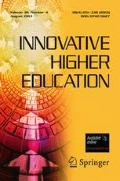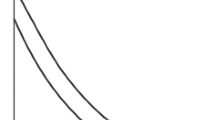Abstract
Researchers consider a high level of institutional diversity in a higher education system as a strength. While the literature considers key elements of diversity, existing research fails to employ methodological approaches that balance the need for capturing the breadth and depth of similarities and differences across institutions. This article reports on the use of cluster analysis to examine data from the Integrated Postsecondary Education Data System (IPEDS) and to create a typology of six institutional types present across four-year institutions in U.S. higher education. The typology presented here helps identify the main types of institutions and offers useful insights for understanding the current state of institutional diversity. Drawing from the research on institutional diversity and organizational theory, the findings of this study provide a typology that can inform both researchers and practitioners as they compare different institutions. An enhanced understanding of the similarities and differences between institutions can clarify not only the range of characteristics and features within U.S. higher education, but also guide administrative decision-making.
Similar content being viewed by others
References
Aldersley, S. F. (1995). “Upward drift” is alive and well: Research/doctoral model still attractive to institutions. Change, 27, 50–56.
Alvesson, M. (2013). Understanding organizational culture. London: SAGE.
Angulo, A. J. (2016). Diploma mills: How for-profit colleges stiffed students, taxpayers, and the American dream. Baltimore, MD: Johns Hopkins University Press.
Barbato, G., & Turri, M. (2019). What do positioning paths of universities tell about the diversity of higher education systems? An exploratory study. Studies in Higher Education, 44, 1–14.
Birnbaum, R. (1983). Maintaining diversity in higher education. San Francisco, CA: Jossey-Bass.
Braxton, J. M. (Ed.). (2000). Reworking the student departure puzzle. Nashville, TN: Vanderbilt University Press.
Calinski, T., & Harabasz, J. (1974). A dendrite method for cluster analysis. Communications in Statistics, 3, 1–27.
Casselman, B. (2016, March 30). Shut up about Harvard. FiveThirtyEight.com. Retrieved from https://fivethirtyeight.com/features/shut-up-about-harvard/
Cohen, A. M., & Brawer, F. B. (2008). The American community college (5th ed.). San Francisco, CA: Jossey-Bass.
Cole, J. R. (2009). The great American university: Its rise to preeminence, its indispensable national role, why it must be protected. New York, NY: PublicAffairs.
Cottom, T. M. (2017). Lower Ed: The troubling rise of for-profit colleges in the new economy. New York, NY: The New Press.
Crisp, G., Horn, C., Kuczynski, M., Zhou, Q., & Cook, E. (2019). Describing and differentiating four-year broad access institutions: An emprical typology. Review of Higher Education, 42, 1373–1400.
Duda, R. O., Hart, P. E., & Stork, D. G. (2000). Pattern classification. New York, NY: John Wiley.
Eckel, P. D. (2008). Mission diversity and the tension between prestige and effectiveness: An overview of US higher education. Higher Education Policy, 21, 175–192.
Eckel, P. D., & Morphew, C. C. (2009). The organizational dynamics of privatization in public research universities. In C. C. Morphew & P. D. Eckel (Eds.), Privatizing the public university: Perspectives from across the academy (pp. 88–108). Baltimore, MD: Johns Hopkins University Press.
Gandara, D., & Rutherford, A. (2018). Mitigating unintended impacts? The effects of premiums for underserved populations in performance-funding policies for higher education. Research in Higher Education, 59, 681–703.
Gonzales, L. D., Martinez, E., & Ordu, C. (2014). Exploring faculty experiences in a striving university through the lens of academic capitalism. Studies in Higher Education, 39, 1097–1115.
Hannan, M. T. (2010). Partiality of memberships in categories and audiences. Annual Review of Sociology, 36, 159–181.
Harris, M. S. (2013). Understanding institutional diversity in American higher education. San Francisco, CA: Jossey-Bass.
Harris, M. S., & Ellis, M. K. (2019). Measuring changes in institutional diversity: The U.S. context. Higher Education, 2019, 1–16.
Hartley, M., & Morphew, C. C. (2008). What’s being sold and to what end? A content analysis of college viewbooks. Journal of Higher Education, 79, 671–691.
Huberty, C. J., Jordan, E. M., & Brandt, W. C. (2005). Cluster analysis in higher education research. In J. C. Smart (Ed.), Higher education: Handbook of theory and research. XX (pp. 437–547). Dordrecht, Netherlands: Springer.
Huisman, J. (1995). Differentiation, diversity and dependency in higher education. Utrecht, Netherlands: Lemma.
Huisman, J. (1998). Differentiation and diversity in higher education systems. In J. C. Smart (Ed.), Higher education: Handbook of theory and research, XIII (pp. 75–100). Dordrecht, Netherlands: Springer.
Huisman, J. (2000). Higher education institutions: As different as chalk and cheese. Higher Education Policy, 13, 41–53.
Huisman, J., Lepori, B., Seeber, M., Frolich, N., & Scordato, L. (2015). Measuring institutional diversity across higher education systems. Research Evaluation, 24, 369–379.
Huisman, J., Meek, V. L., & Wood, F. (2007). Institutional diversity in higher education: A cross-national and longitudinal analysis. Higher Education Quarterly, 61, 563–577.
Huisman, J., & Morphew, C. C. (1998). Centralization and diversity: Evaluating the effects of government policies in the U.S. and Dutch higher education. Higher Education Policy, 11, 3–13.
Kaufman, L., & Rousseeuw, J. W. (1990). Finding groups in data: An introduction to cluster analysis. New York, NY: Wiley.
Kinser, K. (2006). From Main street to wall street: The transformation of for-profit higher education. San Francisco, CA: Jossey-Bass.
Kinser, K., & Levy, D. C. (2005). The for-profit sector: U.S. patterns and international echoes in higher education. Program for research on private higher education (PROPHE), working paper no. 5. Albany, NY: University of Albany.
Kuh, G. D., Kinzie, J., Schuh, J. H., Whitt, E. J., et al. (2010). Student success in college: Creating conditions that matter. San Francisco, CA: Jossey-Bass.
Lang, D. W. (2000). Similarities and differences: Measuring diversity and selecting peers in higher education. Higher Education, 39, 93–129.
Lederman, D., Stratford, M., & Jaschik, S. (2014, February 7). Rating (and berating) the ratings.InsideHigherEd.com. Retrieved from https://www.insidehighered.com/news/2014/02/07/colleges-and-analysts-respond-obama-ratings-proposal
Milligan, G. W., & Cooper, M. C. (1987). Methodology review: Clustering methods. Applied Psychological Measurement, 11, 329–354.
Morphew, C. C. (2000). Institutional diversity, program acquisition and faculty members: Examining academic drift at a new level. Higher Education Policy, 13, 55–78.
Morphew, C. C. (2009). Conceptualizing change in the institutional diversity of U.S. colleges and universities. The Journal of Higher Education, 80, 243–269.
Morphew, C. C., & Hartley, M. (2006). Mission statements: A thematic analysis of rhetoric across institutional type. Journal of Higher Education, 77, 456–471.
Morphew, C. C., & Huisman, J. (2002). Using institutional theory to reframe research on academic drift. Higher Education in Europe, 27, 492–506.
Ness, E. C., Deupree, M. M., & Gandara, D. (2015). Campus responses to outcomes-based funding in Tennessee: Robust, aligned and contested. Nashville, TN: The Tennessee Higher Education Commission.
Nunez, A.-M., Crisp, G., & Elizondo, D. (2016). Mapping Hispanic-serving institutions: A typology of institutional diversity. Journal of Higher Education, 87, 55–83.
Nunez, A.-M., Sparks, P. J., & Henandez, E. A. (2011). Latino access to community colleges and Hispanic-serving institutions: A national study. Journal of Hispanic Higher Education, 10, 18–40.
O'Meara, K. (2007). Striving for what? Exploring the pursuit of prestige. In J. C. Smart (Ed.), Higher education: Handbook of theory and research, XXII (pp. 121–179). Dordrecht, Netherlands: Springer.
O'Meara, K., & Bloomgarden, A. (2011). The pursuit of prestige: The experience of institutional striving from a faculty perspective. Journal of the Professoriate, 4, 39–73.
Rapkin, B. D., & Luke, D. A. (1993). Cluster analysis in community research: Epistemology and practice. American Journal of Community Psychology, 21, 247–277.
Riesman, D. (1975). The future of diversity in a time of retrenchment. Higher Education, 4, 461–482.
Rossi, F. (2009). Increased competition and diversity in higher education: An empirical analysis of the Italian university system. Higher Education Policy, 22, 389–413.
Seaman, J. E., Allen, I. E., & Seaman, J. (2018). Grade increase: Tracking distance education in the United States. Oakland, CA: Babson Survey Research Group.
Strauss, A. L., & Corbin, J. M. (1998). Basics of qualitative research : Techniques and procedures for developing grounded theory (2nd ed.). Thousand Oaks, CA: SAGE.
Teixeira, P., Rocha, V., Biscaia, R., & Cardoso, M. F. (2012). Competition and diversity in higher education: An emprical approach to specialization patterns of Portuguese institutions. Higher Education, 63, 337–352.
Tierney, W. G. (1988). Organizational culture in higher education: Defining the essentials. Journal of Higher Education, 59, 2–21.
Toma, J. D., Dubrow, G., & Hartley, M. (2005). The uses of institutional culture: Strengthening identification and building brand equity in higher education. San Francisco, CA: Jossey-Bass.
Trow, M. (1974). Problems in the transition from elite to mass higher education. Berkeley, CA: Carnegie Commission on Higher Education.
Trow, M. (1979). Aspects of diversity in American higher education. In H. J. Gans, N. Glazer, J. R. Gusfield, & C. Jencks (Eds.), On the making of Americans: Essays in honor of David Riesman (pp. 271-290). Camden, NJ: University of Pennsylvania Press.
van Vught, F. A. (2009a). Diversity and differentiation in higher education. In F. A. van Vught (Ed.), Mapping the higher education landscape: Towards a European classification of higher education (pp. 1–16). Dordrecht, Netherlands: Springer.
van Vught, F. A. (2009b). Mapping the higher education landscape: Towards a European classification of higher education. Dordrecht, Netherlands: Springer.
Ward, J. H. (1963). Hierarchical grouping to optimize an objective function. Journal of the American Statistical Association, 58, 236–244.
Weisbrod, B. A., Ballou, J. P., & Asch, E. D. (2008). Mission and money: Understanding the university. Cambridge, England: Cambridge University Press.
Acknowledgements
The author would like to thank Sondra Barringer for her useful feedback on this article.
Author information
Authors and Affiliations
Corresponding author
Additional information
Publisher’s Note
Springer Nature remains neutral with regard to jurisdictional claims in published maps and institutional affiliations.
Rights and permissions
About this article
Cite this article
Harris, M.S. An Empirical Typology of the Institutional Diversity of U.S. Colleges and Universities. Innov High Educ 45, 183–199 (2020). https://doi.org/10.1007/s10755-019-09494-6
Published:
Issue Date:
DOI: https://doi.org/10.1007/s10755-019-09494-6




